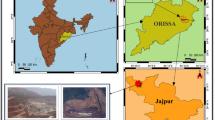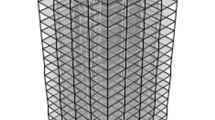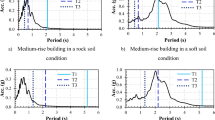Abstract
The aim of this paper is to develop a stochastic-parametric model for the generation of synthetic ground motions (GMs) which are in accordance with a real GM. In the proposed model, the dual-tree complex discrete wavelet transform (DT-CDWT) is applied to real GMs to decompose them into several frequency bands. Then, the gamma modulating function (GMF) is used to simulate the wavelet coefficients of each level. Consequently, synthetic wavelet coefficients are generated using extracted model parameters and then synthetic GM is extracted by applying the inverse DT-CDWT to synthetic wavelet coefficients. This model simulates the time–frequency distribution of both wide-frequency and narrow-frequency bandwidth GMs. Besides being less time consuming, it simulates several dominant frequency peaks at any moment in the time duration of GM, because each frequency band is separately simulated by the gamma function. Moreover, the inelastic response spectra of synthetic GMs generated by the proposed model are a good estimate of target ones. Using the random sign generator in the proposed model, it is possible to generate any number of synthetic GMs in accordance with a recorded one. Because of these advantages, the proposed model is suitable for using in performance-based earthquake engineering.














Similar content being viewed by others
References
Amin M, Ang AHS (1968) Nonstationary stochastic model of earthquake motions. J Eng Mech (ASCE) 94(2):559–584
Assari P, Dehghan M (2019) Application of dual-Chebyshev wavelets for the numerical solution of boundary integral equations with logarithmic singular kernels. Eng Comput 35(1):175–190
Baker JW (2007) Quantitative classification of near-fault ground motions using wavelet analysis. Bull Seismol Soc Am 97(5):1486–1501
Beckouche S, Ma J (2014) Simultaneously dictionary learning and denoising for seismic data. Geophysics 79(3):A27–A31
BHRC (1978) The 1978 Ms 7.4 Tabas-Golshan, Iran, earthquake. Building & House Research Center. http://smd.bhrc.ac.ir/Portal/fa/BigQuakes/Details/40
BHRC (1990) The 1990 Ms 7.7 Rudbar-Manjil, Iran, earthquake. Building & House Research Center. http://smd.bhrc.ac.ir/Portal/fa/BigQuakes/Details/14
BHRC (2012) The 2012 6.1 east Azerbaijan, Iran, earthquake. Building & House Research Center. http://smd.bhrc.ac.ir/Portal/en/BigQuakes/Details/34
Boashash B, Ali Khan N, Ben-Jabeur T (2015) Time–frequency features for pattern recognition using high-resolution TFDs: a tutorial review. Digit Signal Process 40:1–30. https://doi.org/10.1016/j.dsp.2014.12.015
Boßmann F, Ma J (2015) Asymmetric chirplet transform for sparse representation of seismic data. Geophysics 80(6):WD89–WD100
Boßmann F, Ma J (2016) Asymmetric chirplet transform—part 2: phase, frequency, and chirp rate. Geophysics 81(6):V425–V439
Bui Quang P, Gaillard P, Cano Y, Ulzibat M (2015) Detection and classification of seismic events with progressive multi-channel correlation and hidden Markov models. Comput Geosci 83:110–119
Chalfant JS, Patrikalakis NM (2009) Three-dimensional object registration using wavelet features. Eng Comput 25(3):303–318
Conte JP, Peng BF (1997) Fully nonstationary analytical earthquake ground-motion model. J Eng Mech (ASCE) 12:15–24
Dak Hazirbaba Y, Tezcan J (2015) Image based modeling and prediction of nonstationary ground motions. Comput Struct 174:85–91
Duchkov A, Andersson F, De Hoop M (2010) Discrete almost-symmetric wave packets and multiscale geometrical representation of (seismic) waves. IEEE Trans Geosci Remote Sens 48:3408–3423
Hong T, Kennett B (2003) Modelling of seismic waves in heterogeneous media using a wavelet-based method: application to fault and subdection zones. Geophys J Int 154:483–498
Housner GW, Jennings PC (1964) Generation of artificial earthquakes. J Eng Mech (ASCE) 90(1):113–152
Huang D, Wang G (2014) Stochastic simulation of regionalized ground motions using wavelet packets and cokriging analysis. Earthq Eng Struct Dyn 44(5):775–794
Huang D, Wang G (2015) Region-specific spatial cross-correlation model for stochastic simulation of regionalized ground-motion time histories. Bull Seismol Soc Am 105(1):272–284
Huang D, Wang G (2017) Energy-compatible and spectrum-compatible (ECSC) ground motion simulation using wavelet packets. Earthq Eng Struct Dyn 46:1855–1873
IIEES (1990) The 7.3 Rudbar-Manjil, Iran, earthquakes of 20 June 1990. International Institute of Earthquake Engineering and Seismology. http://www.iiees.ac.ir/en/rudbar-manjil-earthquake-of-20-june-1990-mw7-3/
IIEES (2012) The 6.4 and 6.3 Ahar-Varzaqan, Iran, earthquakes of 11 August 2012. International Institute of Earthquake Engineering and Seismology. http://www.iiees.ac.ir/en/ahar-varzeghan-twin-earthquakes-of-11-august-2012-mw-6-4-and-mw-6-3/
Kingsbury NG (1999) Image processing with complex wavelets. Philos Trans R Soc A 357(1760):1–16
Kortström J, Uski M, Tiira T (2016) Automatic classification of seismic events within a regional seismograph network. Comput Geosci 87:22–30
Kumar KH, Vijesh VA (2019) Legendre wavelet-based iterative schemes for fourth-order elliptic equations with nonlocal boundary conditions. Eng Comput. https://doi.org/10.1007/s00366-019-00766-5
Kuyuk HS, Yildirim E, Dogan E, Horasan G (2012) Application of k-means and Gaussian mixture model for classification of seismic activities in Istanbul. Nonlinear Process Geophys 19:411–419
Lin YK (1965) Nonstationary excitation and response in linear systems treated as sequences of random pulses. J Acoust Soc Am 38:453–460
Ma J, Plonka G, Chauris H (2010) A new sparse representation of seismic data using adaptive easy-path wavelet transform. IEEE Geosci Remote Sens Lett 7:540–544
Mallat S (1998) A wavelet tour of signal processing. Academic, San Diego
Medel-Vera C, Ji T (2016) A stochastic ground motion accelerogram model for Northwest Europe. Soil Dyn Earthq Eng 82:170–195
Mobarakeh AA, Rofooei FR, Ahmadi G (2002) Simulation of earthquake records using time-varying ARMA model. Probab Eng Mech 17:15–34
Oruç Ö (2019) An efficient wavelet collocation method for nonlinear two-space dimensional Fisher–Kolmogorov–Petrovsky–Piscounov equation and two-space dimensional extended Fisher–Kolmogorov equation. Eng Comput. https://doi.org/10.1007/s00366-019-00734-z
Rezaeian S, Der Kiureghian A (2010) Simulation of synthetic ground motions for specified earthquake and site characteristics. Earthquake Eng Struct Dynam 39(10):1155–1180
Ruiz P, Penzien J (1971) Stochastic seismic response of structures. J Eng Mech (ASCE) 97:441–456
Sabetta F, Pugliese A (1996) Estimation of response spectra and simulation of nonstationary earthquake ground motions. Bull Seismol Soc Am 86:337–352
Saragoni GR, Hart GC (1974) Simulation of artificial earthquakes. Earthq Eng Struct Dyn 2(3):249–267
Sharbati R, Khoshnoudian F, Ramazi HR, Amindavar HR, Rabbani H (2019) Stochastic model for simulation of ground-motion sequences using kernel-based smoothed wavelet transform and Gaussian mixture distribution. J Earthq Eng. https://doi.org/10.1080/13632469.2019.1605948
Sharbati R, Khoshnoudian F, Ramazi HR, Amindavar HR (2018) Stochastic modeling and simulation of ground motions using complex discrete wavelet transform and Gaussian mixture model. Soil Dyn Earthq Eng 114:267–280
Shinozuka M, Sato Y (1967) Simulation of nonstationary random process. J Eng Mech (ASCE) 93(1):11–40
Stafford PJ, Sgobba S, Marano GC (2009) An energy-based envelope function for the stochastic simulation of earthquake accelerograms. Soil Dyn Earthq Eng 29:1123–1133
Tazarv M (2011) Quantitative identification of near-fault ground motion using baker’s method; an application for March 2011 Japan M9.0 earthquake. http://alum.sharif.ir/~tazarv/. Accessed 05 Apr 2019
Tezcan J, Cheng J, Cheng Q (2014) Modeling and prediction of nonstationary ground motions as time–frequency images. IEEE Trans Geosci Remote Sens PP(99):1–8
Tsioulou A, Taflanidis AA, Galasso C (2017) Modification of stochastic ground motion models for matching target intensity measures. Earthq Eng Struct Dyn 47(1):3–24
USGS (1996) Magnitude 6.8—Kobe, Japan, United States Geological Survey. https://archive.usgs.gov/archive/sites/www.usgs.gov/newsroom/article.asp-ID=744.html
Vetter CR, Taflanidis AA, Mavroeidis GP (2016) Tuning of stochastic ground motion models for compatibility with ground motion prediction equations. Earthq Eng Struct Dyn 45:893–912
Vlachos C, Papakonstantinou KG, Deodatis G (2016) A multi-modal analytical non-stationary spectral model for characterization and stochastic simulation of earthquake ground motions. Soil Dyn Earthq Eng 30:177–191
Vlachos C, Papakonstantinou KG, Deodatis G (2018) Predictive model for site specific simulation of ground motions based on earthquake scenarios. Earthq Eng Struct Dyn 47:195–218
Wang D, Fan Z, Hao S, Zhao D (2018) An evolutionary power spectrum model of fully nonstationary seismic ground motion. Soil Dyn Earthq Eng 105:1–10
Wang L, McCullough M, Kareem A (2014) Modeling and simulation of nonstationary processes utilizing wavelet and Hilbert transforms. J Eng Mech 140:345–360
Wen YK, Gu P (2004) Description and simulation of nonstationary processes based on Hilbert spectra. J Eng Mech (ASCE) 130:942–951
Yaghmaei-Sabegh S (2010) Detection of pulse-like ground motions based on continues wavelet transform. J Seismol 14:715–726
Yamamoto Y, Baker JW (2013) Stochastic model for earthquake ground motion using wavelet packets. Bull Seismol Soc Am 103(6):3044–3056
Zerva A (1988) Seismic source mechanisms and ground motion models, review paper. Probab Eng Mech 3:64–74
Zhang Y, Zhao F (2010) Artificial ground motion compatible with specified peak ground displacement and target multi-damping response spectra. Nucl Eng Des 240:2571–2578
Zhang Y, Zhao F, Yang C (2015) Generation of nonstationary ground motions compatible with multi-damping response spectra. Bull Seismol Soc Am 105:341–353
Author information
Authors and Affiliations
Corresponding author
Additional information
Publisher's Note
Springer Nature remains neutral with regard to jurisdictional claims in published maps and institutional affiliations.
Rights and permissions
About this article
Cite this article
Sharbati, R., Khoshnoudian, F., Koopialipoor, M. et al. Applying dual-tree complex discrete wavelet transform and gamma modulating function for simulation of ground motions. Engineering with Computers 37, 1519–1535 (2021). https://doi.org/10.1007/s00366-019-00898-8
Received:
Accepted:
Published:
Issue Date:
DOI: https://doi.org/10.1007/s00366-019-00898-8




